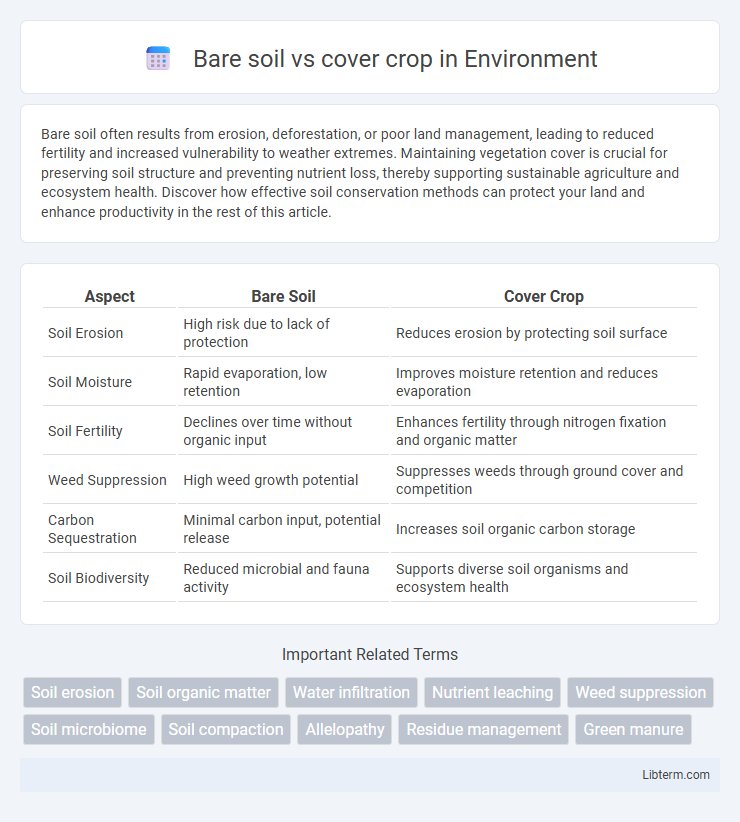Bare soil often results from erosion, deforestation, or poor land management, leading to reduced fertility and increased vulnerability to weather extremes. Maintaining vegetation cover is crucial for preserving soil structure and preventing nutrient loss, thereby supporting sustainable agriculture and ecosystem health. Discover how effective soil conservation methods can protect your land and enhance productivity in the rest of this article.
Table of Comparison
| Aspect | Bare Soil | Cover Crop |
|---|---|---|
| Soil Erosion | High risk due to lack of protection | Reduces erosion by protecting soil surface |
| Soil Moisture | Rapid evaporation, low retention | Improves moisture retention and reduces evaporation |
| Soil Fertility | Declines over time without organic input | Enhances fertility through nitrogen fixation and organic matter |
| Weed Suppression | High weed growth potential | Suppresses weeds through ground cover and competition |
| Carbon Sequestration | Minimal carbon input, potential release | Increases soil organic carbon storage |
| Soil Biodiversity | Reduced microbial and fauna activity | Supports diverse soil organisms and ecosystem health |
Introduction to Bare Soil and Cover Crops
Bare soil exposes the ground to erosion, nutrient loss, and moisture depletion, negatively impacting soil health and crop productivity. Cover crops improve soil structure, increase organic matter, and protect against erosion by providing continuous vegetative cover during off-season periods. Integrating cover crops into agricultural systems enhances soil fertility, supports biodiversity, and promotes sustainable farming practices.
Soil Health: Bare Soil vs Cover Crop
Cover crops significantly improve soil health by enhancing nutrient cycling, increasing organic matter, and promoting microbial diversity, whereas bare soil often leads to nutrient depletion, erosion, and reduced biological activity. The presence of cover crops protects the soil surface, reduces compaction, and maintains moisture levels, supporting robust root systems and overall soil structure. Bare soil conditions typically result in increased vulnerability to erosion and loss of soil fertility, negatively impacting long-term agricultural productivity.
Erosion Control: Benefits of Ground Coverage
Bare soil is highly susceptible to erosion due to the lack of protective vegetation, leading to significant topsoil loss during heavy rainfall and wind events. Cover crops provide effective ground coverage, reducing soil erosion by stabilizing the soil surface with root systems and minimizing water runoff. Implementing cover crops like clover or ryegrass improves soil structure and enhances long-term soil health by maintaining soil integrity and preventing nutrient depletion.
Water Retention and Moisture Management
Cover crops significantly improve soil water retention by reducing surface evaporation and increasing organic matter, which enhances moisture-holding capacity compared to bare soil. Bare soil is prone to rapid moisture loss due to direct exposure to sunlight and wind, leading to decreased water availability for crops. Implementing cover crops creates a protective mulch layer, moderates soil temperature, and promotes better infiltration, optimizing moisture management in agricultural systems.
Weed Suppression: Cover Crop Advantages
Cover crops provide effective weed suppression by shading the soil, reducing light availability that inhibits weed germination and growth. Their dense root systems compete with weeds for nutrients and moisture, further limiting weed establishment. This natural weed control method decreases reliance on herbicides and promotes healthier soil ecosystems compared to bare soil conditions.
Soil Biodiversity and Microbial Activity
Cover crops significantly enhance soil biodiversity and microbial activity by providing continuous organic matter and root exudates that sustain diverse microbial communities, whereas bare soil often leads to reduced microbial populations due to lack of nutrients and habitat. Increased microbial biomass and enzymatic activity under cover crops improve nutrient cycling and soil structure, promoting resilient and fertile soil ecosystems. Bare soil exposes microbes to harsh environmental conditions, resulting in lower microbial diversity and diminished soil health over time.
Nutrient Cycling and Soil Fertility
Cover crops enhance nutrient cycling by capturing residual soil nitrogen and converting it into organic matter, reducing nutrient leaching compared to bare soil. Bare soil often suffers from nutrient depletion due to erosion and lack of organic inputs, leading to decreased soil fertility over time. Incorporating cover crops improves soil structure and microbial activity, which promotes sustained nutrient availability and long-term fertility.
Economic Considerations: Costs and Returns
Bare soil management typically incurs lower initial costs due to the absence of expenses for seeds, planting, and maintenance associated with cover crops. Cover crops, while requiring investment in seeds, labor, and equipment, enhance soil fertility, reduce erosion, and improve water retention, leading to higher long-term crop yields and profitability. Economic analyses consistently show that cover crops increase net returns over multiple seasons by reducing input costs such as fertilizers and irrigation, outweighing the upfront expenses compared to bare soil systems.
Long-term Sustainability and Climate Resilience
Cover crops improve long-term sustainability by enhancing soil health, increasing organic matter, and reducing erosion compared to bare soil. They promote climate resilience through improved water retention, nutrient cycling, and carbon sequestration, helping to buffer crops against extreme weather events. In contrast, bare soil is more vulnerable to degradation, nutrient loss, and decreased microbial activity, undermining ecosystem stability and agricultural productivity over time.
Choosing the Best Practice for Your Land
Choosing between bare soil and cover crops depends on your land's health and erosion risk. Cover crops improve soil structure, boost nutrient retention, and protect against water runoff, benefiting long-term productivity. Bare soil may be suitable for short-term management but increases vulnerability to erosion and nutrient loss.
Bare soil Infographic

 libterm.com
libterm.com